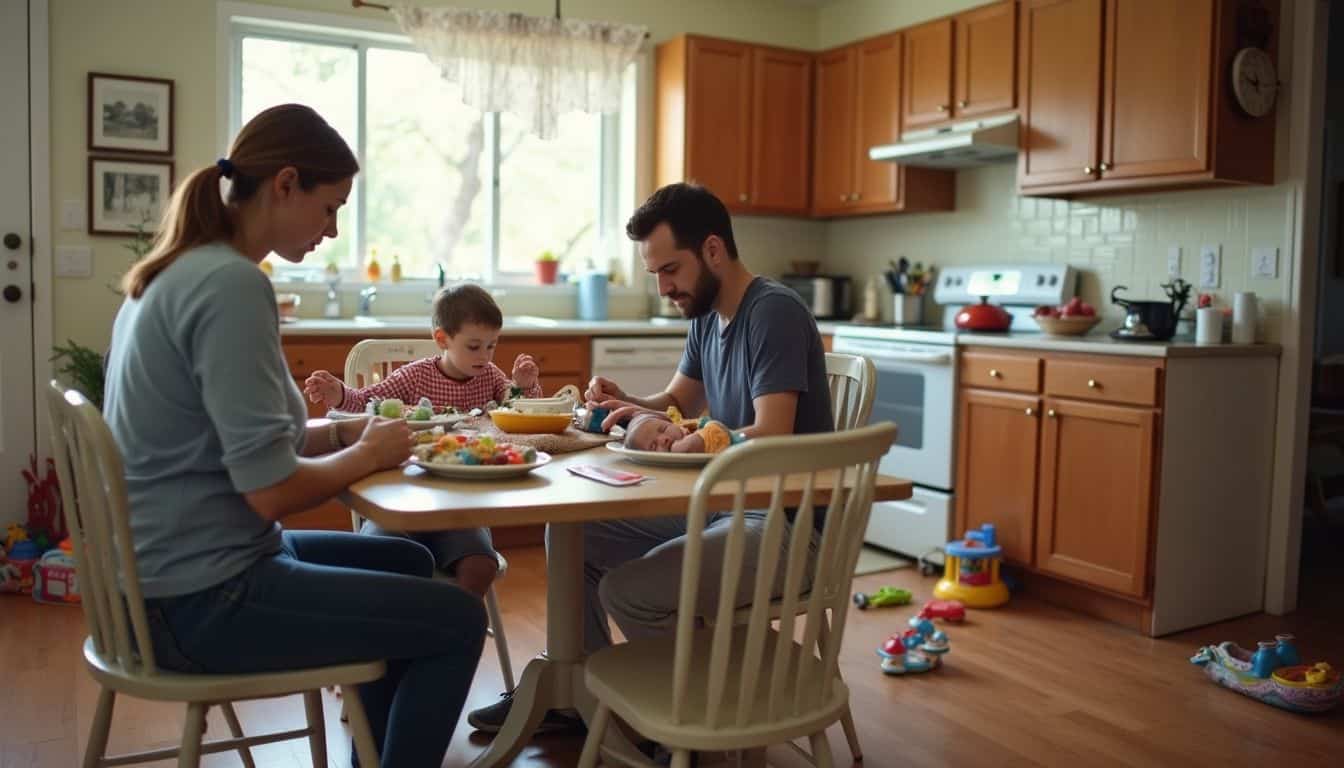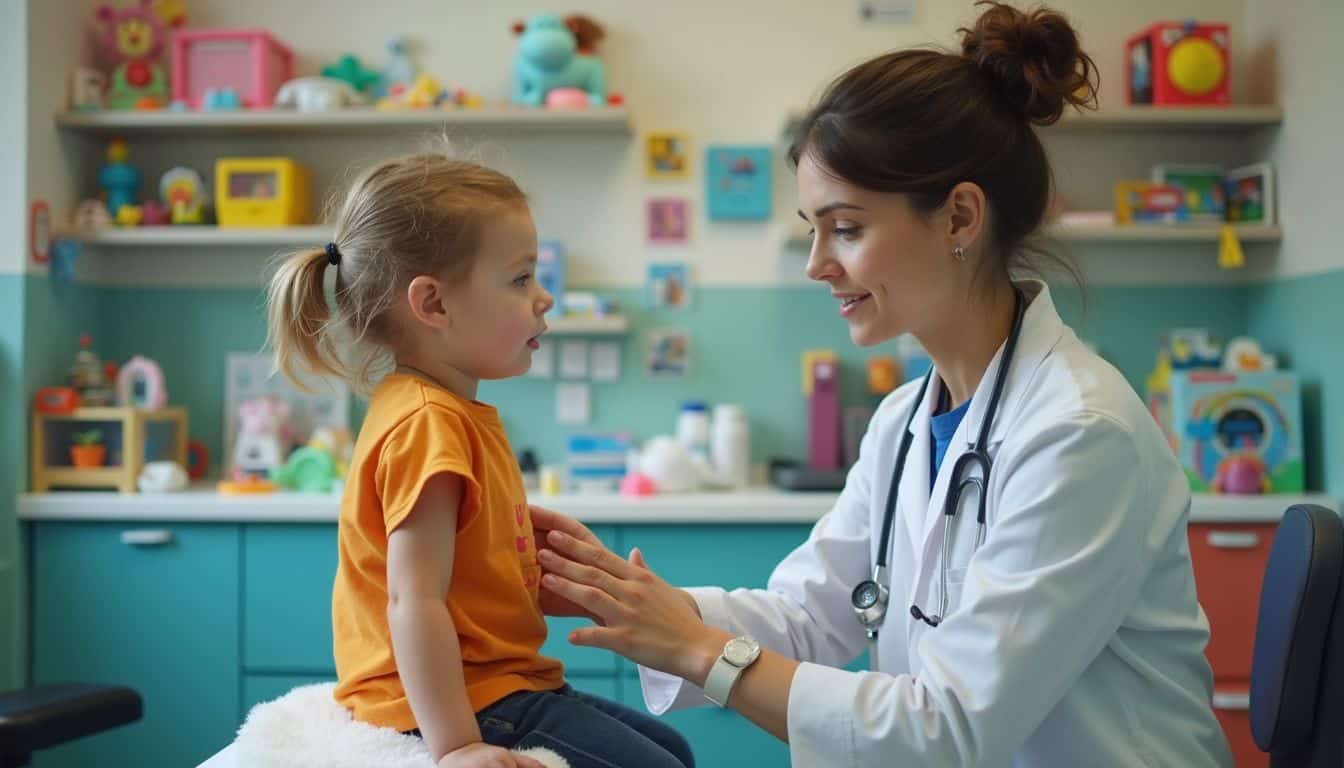Have you ever sat in a doctor’s office and heard the term “paediatric” and wondered, “Isn’t that just a fancy word for anything related to a child?”
You’re not alone in asking what the difference between child and paediatric is. While they seem interchangeable, they have distinct meanings that are super helpful to know.
In short, “child” is who your little one is, and “pediatric” describes the special kind of medical care they receive. The word “pediatric” actually comes from the Greek words for “child” (pais) and “doctor” (iatros).
I’m going to walk you through what each term really means and why getting it right matters for your child’s health and development.
Key Takeaways
A “child” is a young person, but the exact age range changes depending on who you ask. The United Nations says anyone under 18 is a child, while some U.S. laws go up to age 21.
“Pediatric” is a specific medical term for the healthcare of infants, children, and teens. It’s a field of medicine, not a description of a person.
Pediatricians are medical doctors who use special tools and knowledge for growing bodies, like age-specific medicine dosing and developmental screenings. Children’s bodies are not just small adult bodies; they have unique physiological needs.
Pediatric medicine has many subspecialties, such as pediatric cardiology for heart issues and pediatric oncology for childhood cancers, all guided by organizations like the American Academy of Pediatrics.
You’ll hear “child” used in everyday life, at school, and in legal papers. You’ll only hear “pediatric” in a healthcare setting like a hospital or a medical journal.
Table of Contents
What does the term “Child” mean?

A child is generally anyone from birth through puberty, but different rules and laws can stretch that definition quite a bit.
The United Nations Convention on the Rights of the Child, for example, defines a child as anyone under 18. However, U.S. immigration law considers someone a “child” until they are under age 21. These definitions are important because they determine who qualifies for certain protections and services.
In the world of medical research, databases like PubMed often filter “child” as anyone from birth to 18 years old. Biologically, the term usually refers to the period between birth and the start of adolescence. This is why a pediatrician’s waiting room can be filled with everyone from tiny newborns to middle schoolers.
Children’s healthcare specialists in the city, along with social workers and educators, rely on these definitions to plan everything from vaccine schedules to mental health screenings.
“According to the American Academy of Pediatrics, understanding who qualifies as a ‘child’ shapes every decision in pediatric medicine.”
What does “Pediatric” refer to?

“Pediatric” is a term that comes from the Greek words “paedo,” meaning child, and “iatros,” meaning physician. It describes the medical specialty focused entirely on the health of infants, kids, and teens.
Doctors who finish medical school and then complete years of extra training in this field are called pediatricians. They are the experts in child health, and their care often extends from birth up to age 18. The U.S. Food and Drug Administration (FDA) even defines pediatric patients as anyone from birth through age 21 for the purposes of medical device regulation.
Interestingly, the American Academy of Pediatrics used to suggest 21 as the upper age limit for care but now says the decision should be flexible and based on a patient’s individual needs. This is especially helpful for young adults with chronic conditions diagnosed in childhood, like cystic fibrosis, who benefit from a consistent care team.
Pediatric care covers everything from preventive services like vaccines and developmental screenings to managing complex conditions in specialized fields.
- Neonatology focuses on the health of newborn infants, especially those born prematurely or with complications.
- Pediatric cardiology deals with heart conditions in children.
- Pediatric oncology is dedicated to treating childhood cancers like leukemia.
- Developmental-behavioral pediatrics helps with conditions like ADHD and autism.
These specialists work with general pediatricians, nurses, and child psychologists to make sure every aspect of a child’s well-being is looked after.
Key characteristics of a child

Children grow and change incredibly fast, learning through play and feeling all their emotions in a big way. Let’s look at how these changes shape their lives from one stage to the next.
What are the physical and emotional development stages of a child?
Watching a child grow is an amazing experience. From those first babbles to their teenage years, every stage is full of new skills and milestones.
The Centers for Disease Control and Prevention (CDC) provides helpful milestones to track a child’s progress. It’s a great guide to know what to expect as they grow.
- Motor Development: This starts right away. Babies often learn to stand and take their first steps by 15 months. I’ll never forget my daughter’s first wobbly steps across the living room floor.
- Language Skills: By age two, many kids start putting two words together, like “more milk.” It’s the beginning of them expressing their wants and needs.
- Cognitive Growth: Between one and four, their imagination takes off. A cardboard box can become a race car, which is a sign of their growing problem-solving abilities.
- Social and Emotional Skills: Around age four, children start to show empathy. I once saw my son comfort a friend who fell, a sweet moment that showed he was learning to understand others’ feelings.
- Physical Changes: As they grow, kids’ bodies change constantly. They run faster, jump higher, and gradually grow into their teenage frames.
In 2022, the CDC updated its guidelines for developmental milestones. The new benchmarks reflect what 75% of children can do at a certain age, up from the previous 50% mark. This change was made to help reduce worry for parents if their child is a little behind the average.
If there are concerns about development, pediatric neurologists or other specialists can step in. But for most kids, love and support from caregivers are the most important factors for healthy emotional development.
What is the typical age range for a child?
After understanding the different stages, it’s helpful to know the official age ranges that define a child.
Early childhood covers the period from birth to age six, which includes infants and toddlers. Middle childhood is generally from ages seven to ten. Late childhood, or preadolescence, covers the nine to twelve age range, though every child develops at their own pace.
Pediatric healthcare providers typically see children for primary care from birth up to age 18. They track everything from language skills in toddlers to cognitive leaps in preschoolers.
Experts like Edward A. Park first outlined these developmental ranges many years ago, and modern medical science still builds on that foundation for well-being checks and disease prevention efforts.
Children go through many changes between birth and adolescence; each year brings new skills, challenges, and breakthroughs.
Key aspects of pediatric care

Pediatricians use their specialized training to care for children’s health problems, from a sudden fever to long-term wellness. Let’s explore how they tailor their care specifically for kids.
How does pediatric care focus on children’s medical needs?
Medical doctors who specialize in pediatric care are experts in how children’s bodies grow and develop. They use tools like growth charts and health screenings to track developmental milestones during regular check-ups.
A pediatrician knows that a child’s body processes medicine differently than an adult’s. They carefully calculate doses based on weight and organ maturity. For example, an infant’s liver enzymes aren’t fully developed, which affects how their body metabolizes a drug like ampicillin.
A huge part of pediatric care is prevention. This includes immunizations, advice on healthy habits, and early detection of issues like congenital heart defects or pediatric cancers. Parents and older children are included in decision-making, helping kids gain autonomy over their health as they grow.
Specialists like neonatologists and neurosurgeons often work together in clinics and hospitals. According to GG Healthcare, pediatric doctors customize their care for everything from birth defects to rare diseases, ensuring each child gets exactly what they need.
What specialized healthcare practices are involved in pediatrics?
Pediatrics is a wide field with many specialized healthcare practices designed just for kids. These cover everything from prevention to treatment throughout their formative years.
- Preventive Care: This is the foundation of pediatrics. It includes routine check-ups, immunizations, and guidance on nutrition and safety to keep kids healthy.
- Subspecialties: Beyond general pediatrics, there are many specialties. Neonatologists care for newborns, pediatric cardiologists treat heart conditions, and pediatric oncologists help children with cancer.
- Developmental Monitoring: Pediatricians track developmental milestones to spot any early signs of behavioral or learning differences and support emotional health.
- Pediatric Radiology: This field uses imaging tools like X-rays and MRIs that are specially adapted to be safe and comfortable for small bodies.
- Team-Based Care: Pediatricians work with nurses, child life specialists, and therapists to support a child’s complete well-being, always following principles of clinical ethics and informed consent.
- Specialized Dosing: Doctors carefully calculate medication doses for children, considering how their bodies absorb and process drugs differently than adults.
- Continuing Education: The medical profession is always learning. The American Academy of Pediatrics provides guidelines and research to keep pediatricians updated on the best practices.
- Advanced Subspecialties: There are even more focused areas, like pediatric pulmonology for lung diseases such as asthma and cystic fibrosis.
All these practices work together to support children’s health from their first day of life into young adulthood.
How do “Child” and “Pediatric” differ?
At the end of the day, a “child” refers to a young person, while “pediatric” refers to the medical field dedicated to their health. Let’s break down how these terms are used in the real world.
What are the terminological differences between child and pediatric?
Let’s sort out the difference between “child” and “pediatric” with a quick and clear breakdown.
| Term | Meaning | Origin | Age Range | Context of Use | Examples |
|---|---|---|---|---|---|
| Child | Refers to a young person, usually between birth and adolescence. | Old English “cild” (infant, unborn or newly born). | Varies widely. The UN uses under 18, while some organizations may say birth to puberty. | Used in everyday conversation, legal documents, education, and social settings. | Calling your eight-year-old for dinner. Legal forms asking, “Do you have children under 18?” |
| Pediatric (or Paediatric) | Relates to the branch of medicine focused on children’s health. | Greek “paedo” (child) + “iatros” (doctor). | Typically birth to 18, but can extend up to 21 depending on the context, such as for FDA guidelines. | Used only in healthcare, medical research, and clinical settings. | A visit to the pediatrician’s office. The journal Pediatric Radiology focuses on medical imaging for patients under 18. |
In simple terms, “child” is about who someone is, while “pediatric” is about the medical care they receive. | |||||
How do their scope and usage contexts differ?
Knowing when to use “child” versus “pediatric” can make conversations at the doctor’s office or school a lot clearer. Here’s a simple comparison to help you out.
| Aspect | “Child” | “Pediatric” |
|---|---|---|
| Meaning | A young human being, from birth through their teenage years. | Anything related to the medical care of children. It’s strictly a healthcare term. |
| Scope | General and broad. Used when talking about parenting, school, or legal matters. | Specialized and narrow. Used in healthcare settings like hospitals and clinics. |
| Age Range | Flexible. Can mean anyone under 18, or sometimes older, depending on the context. | More precise. Usually refers to patients under 18, although it can sometimes extend to 21. |
| Examples of Use | Parenting blogs, school enrollment forms, and discussions about child development. | Pediatric surgery, pediatric nurse, and pediatric oncology are all examples of specialized medical fields. |
| Context Consistency | Can change depending on culture, law, or even family norms. | Strict. Medical journals and institutions have very clear definitions to ensure research is consistent. |
If you’re looking for more support on your parenting journey, you might find this advice on childcare for single parents helpful.
How will the concepts of “Child” and “Pediatric” evolve in 2025?
In the coming years, parents can expect to see technology play an even bigger role in pediatric care. Telehealth, in particular, is becoming a key part of how children receive medical attention.
The pediatric telehealth market is growing rapidly and is expected to reach approximately $280.6 billion by 2033. This shift means more families will have access to care through smart apps and video calls, making it easier to track milestones and connect with doctors. This is especially true for mental health services, where telehealth has remained very popular.
Doctors will use these tools to monitor growth and development, allowing them to spot any potential delays earlier. Instead of rigid age charts, the focus will be on flexible milestones, with guidance from organizations like the American Academy of Pediatrics. This means if a concern arises, a pediatrician might refer a child to a specialist sooner, without waiting for an emergency.
This blend of technology and personalized care will strengthen the partnership between families and healthcare teams, supporting every child’s healthy development from infancy into their teen years.
People Also Ask
What is the main difference between child and paediatric care?
Child refers to a young person, while paediatric care is the specialized medical field for them. The American Academy of Pediatrics provides guidelines for this care, which typically covers patients from birth up to age 21.
Who was Edwards A. Park, and why does he matter here?
Edwards A. Park was a pioneering American pediatrician whose research in the 1920s was instrumental in helping to eliminate the childhood bone disease of rickets.
How does gastric emptying relate to paediatrics?
Gastric emptying is the speed at which food leaves the stomach, a key factor doctors use to determine correct medication timing and feeding schedules for infants. For example, a study in the journal *Clinical Pharmacokinetics* noted that a newborn’s stomach can empty in about half the time of an adult’s, affecting how drugs are absorbed.
Why is decision-making important in paediatric medicine?
Decision-making is centered on the principle of the “best interests of the child,” a standard promoted by the American Academy of Pediatrics. This ensures all treatment choices are ethically sound and safe for a patient who cannot consent on their own.
References
https://en.wikipedia.org/wiki/Child
https://www.news-medical.net/health/What-is-Pediatrics.aspx
https://my.clevelandclinic.org/health/articles/21559-child-development
https://www.ncbi.nlm.nih.gov/books/NBK310550/
https://www.greatbeginningspediatrics.com/3-key-differences-between-adolescent-and-pediatric-care
https://samaritanaclinics.com/what-is-pediatric-care-how-it-differs-from-regular-healthcare/ (2025-07-11)
https://www.ncbi.nlm.nih.gov/books/NBK599760/
https://pmc.ncbi.nlm.nih.gov/articles/PMC9411830/
https://pmc.ncbi.nlm.nih.gov/articles/PMC10132184/
https://www.sciencedirect.com/science/article/abs/pii/S0882596324003968
https://www.ama-assn.org/about/ethics/pediatric-decision-making-help-parents-protect-empower-kids (2019-12-26)
